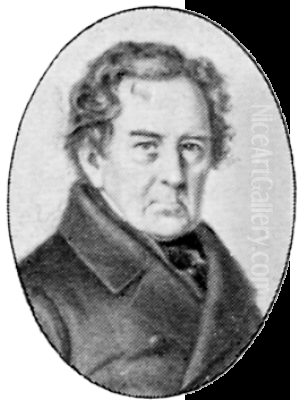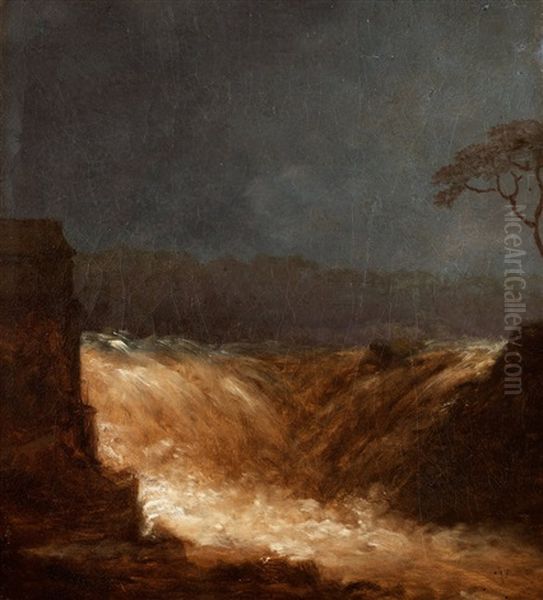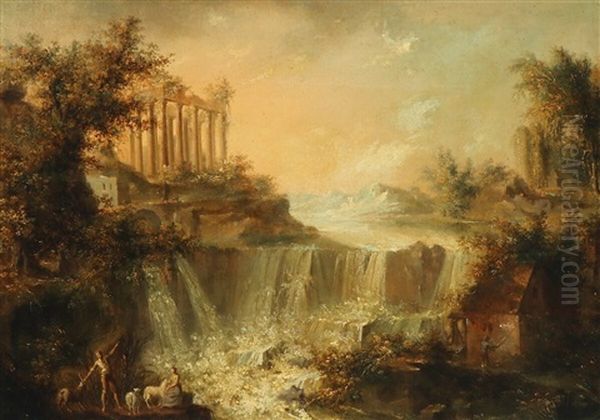
Carl Johan Fahlcrantz stands as a monumental figure in the annals of Swedish art history, particularly celebrated for his pioneering work in landscape painting during the apogee of the Romantic era. His canvases, imbued with a profound sensitivity to the Nordic environment, captured the sublime beauty, inherent melancholy, and dramatic grandeur of Sweden's natural vistas. As a professor, an influential member of artistic societies, and a dedicated practitioner of his craft, Fahlcrantz not only produced a significant body of work but also helped shape the trajectory of landscape art in Scandinavia.
Early Life and Artistic Awakening
Born on November 29, 1774, in the parish of Stora Tuna in Dalarna, Sweden, Carl Johan Fahlcrantz hailed from a family with clerical roots; his father was a vicar. This upbringing in a region known for its rich folk traditions and striking natural beauty may have subtly influenced his later artistic inclinations. The call of art, however, led him away from the ecclesiastical path. In 1790, at the age of sixteen, Fahlcrantz made the pivotal move to Stockholm, the vibrant cultural and artistic heart of Sweden.
His initial foray into the art world was not directly as a painter of grand landscapes but as a decorative painter. He found employment at the Royal Swedish Opera (then often associated with the Royal Dramatic Theatre), where he honed his skills under the guidance of artists experienced in creating stage scenery. This theatrical background, with its emphasis on illusion, atmosphere, and dramatic effect, likely provided a unique foundation for his later landscape work, teaching him how to compose scenes and manipulate light for emotional impact. Among the artists active in Stockholm's theatre and decorative arts scene around this time were figures like Louis Jean Desprez, whose dramatic architectural fantasies and stage designs were highly influential.
Ascent in the Academic World

Fahlcrantz's talent for depicting nature did not go unnoticed. By 1793, he was recognized as the first dedicated landscape painter at the prestigious Royal Swedish Academy of Fine Arts (Konstakademien) in Stockholm. This was a significant development, as landscape painting was gradually gaining status as an independent genre, moving beyond its traditional role as mere background for historical or mythological scenes.
His association with the Academy deepened over the years. In 1803, Carl Johan Fahlcrantz was formally elected as a member of the Academy, a testament to his growing reputation and skill. This membership placed him among the leading artists of his generation in Sweden. Two years later, in 1805, he was awarded a coveted travel scholarship by the Academy. Such scholarships were typically intended for study in Italy, the traditional mecca for artists seeking to immerse themselves in classical art and the idealized landscapes of masters like Claude Lorrain and Nicolas Poussin.
Interestingly, Fahlcrantz chose a different path. Instead of journeying south to Italy, he decided to utilize the funds for extensive travel within Sweden and Norway. This decision was crucial, as it allowed him to directly engage with the specific character of the Nordic landscape – its forests, mountains, lakes, and dramatic skies. Over the next four years, this immersive experience resulted in the creation of six significant oil landscapes, which further solidified his focus on his native scenery. During some of his travels, he was accompanied by fellow painter Gustaf Hasselgren, another notable Swedish artist of the period, known for his historical paintings and portraits.
The culmination of his academic rise came in 1815 when Fahlcrantz was bestowed with the title of Professor of Landscape Painting at the Royal Swedish Academy of Fine Arts. This was a prestigious appointment, making him a key figure in the education of subsequent generations of Swedish artists. He even served as the president of the Academy for a period, underscoring his esteemed position within the Swedish art establishment. His influence extended beyond Sweden; by 1856, he was recognized as an honorary member of the art academies in New York and Philadelphia.
The Romantic Vision: Style and Influences

Carl Johan Fahlcrantz is unequivocally a representative of the Romantic movement in art. His work embodies the core tenets of Romanticism: an emphasis on emotion over reason, a fascination with the power and beauty of nature, and a tendency towards the picturesque and the sublime. He was particularly drawn to the wilder, untamed aspects of the Swedish landscape, often depicting scenes of dense forests, rugged mountains, cascading waterfalls, and expansive skies, frequently under dramatic lighting conditions such as sunrise, sunset, or moonlight.
His style was characterized by a meticulous attention to detail, particularly in the rendering of foliage, rock formations, and water. Yet, this detail was always subservient to the overall atmospheric effect. He was a master of capturing the subtle nuances of light and shadow, using them to create a sense of depth, mood, and often, a touch of melancholy or mystery. His palette, while capable of richness, often leaned towards cooler tones, reflecting the Nordic light, with deep greens, blues, and earthy browns predominating, often punctuated by the warm glow of a setting sun or the ethereal light of the moon.
While his primary inspiration was the direct observation of Swedish nature, Fahlcrantz's work also shows an awareness of the broader European landscape tradition. Echoes of 17th-century Dutch masters like Jacob van Ruisdael, known for his dramatic forest scenes and waterfalls, can be discerned. The idealized, atmospheric landscapes of Claude Lorrain, with their carefully structured compositions and poetic light, also seem to have been an influence, though Fahlcrantz translated these classical sensibilities into a distinctly Nordic idiom. He was less inclined towards the overtly turbulent and sublime visions of someone like Salvator Rosa, preferring a more contemplative, though still deeply felt, engagement with nature.
His contemporary, the Norwegian painter Johan Christian Dahl, who studied in Copenhagen and later settled in Dresden (a hub of German Romanticism alongside Caspar David Friedrich), shared a similar dedication to depicting Nordic landscapes with Romantic fervor. While Dahl's style often had a more rugged, immediate quality, both artists were pioneers in establishing a distinct Scandinavian school of landscape painting.
Key Themes and Notable Works
Fahlcrantz's oeuvre is dominated by landscapes, and he was, in fact, one of the first Swedish artists to dedicate himself almost exclusively to this genre. Water, in its various forms – tranquil lakes, rushing rivers, and powerful waterfalls – was a recurring motif. One of his significant series of works, created between 1802 and 1822 for the Stockholm Academy of Arts, included seven landscapes, among which was a piece often referred to as "Dam Landscape" or, more broadly, depictions of waterfalls ("Vattenfall"). These works showcased his ability to capture the dynamic energy of moving water and the rugged beauty of its surroundings.
His paintings often evoke a specific time of day, with a preference for the transitional moments of dawn and dusk. These times allowed him to explore the subtle interplay of light and shadow, creating scenes imbued with a sense of tranquility, nostalgia, or even a gentle foreboding. "Sunset in the Mountains" is an example of a title that reflects this preoccupation. He was adept at rendering the hazy mists that often soften the Nordic landscape, lending his scenes a dreamlike, almost ethereal quality. The depiction of dense forests, with intricately rendered trees and deep, shadowy interiors, was another hallmark of his style.
While celebrated for his evocative power, some contemporary and later critics noted a degree of repetitiveness in his motifs and compositions, particularly in his treatment of trees and certain landscape elements. However, this consistency can also be seen as a dedicated exploration of specific themes and a refinement of his personal vision of the Swedish wilderness. His works were highly sought after during his lifetime, adorning the collections of royalty and discerning collectors. Today, significant holdings of his paintings can be found in the Nationalmuseum in Stockholm, the Gothenburg Museum of Art, and within the collections of the Royal Swedish Academy of Fine Arts itself.
Other notable Swedish artists of his era, though perhaps in different genres, include Pehr Hilleström, known for his genre scenes and depictions of industrial environments, and Alexander Lauréus, who also painted genre scenes and portraits. Fahlcrantz's singular focus on landscape set him apart and defined his primary contribution.
The Götiska Förbundet and National Romanticism
In 1818, Carl Johan Fahlcrantz became a member of the Götiska Förbundet (the Geatish Society, or Gothic Society). This was an influential cultural and literary society founded in Stockholm in 1811 by a group of intellectuals and artists. The Götiska Förbundet aimed to revive the spirit of Sweden's ancient past, particularly the Viking Age, and to promote a sense of national identity rooted in Norse mythology, history, and folklore. This movement, often termed "Gothicism" or National Romanticism, had a profound impact on Swedish arts and letters in the 19th century.
For a landscape painter like Fahlcrantz, membership in such a society likely reinforced his commitment to depicting the Swedish landscape. The natural environment was seen as intrinsically linked to national character and history – the very stage upon which the sagas of old had unfolded. His paintings, with their often solemn and majestic portrayal of primeval forests and ancient mountains, resonated with the National Romantic ideals of the Götiska Förbundet. While his works rarely included explicit mythological or historical figures, the atmosphere he created often evoked a sense of timelessness and a connection to a storied past. This alignment with nationalistic cultural currents further enhanced his popularity and significance. Other prominent members of the society included the poet Esaias Tegnér and the historian Erik Gustaf Geijer.
Fahlcrantz as a Teacher and Mentor
As Professor of Landscape Painting at the Academy, Fahlcrantz played a crucial role in shaping the next generation of artists. His studio would have been a place where students learned the techniques of landscape painting, from sketching outdoors (en plein air, though less common as a final practice then) to composing and finishing works in the studio. He emphasized the importance of observing nature closely, yet also imbuing it with artistic feeling.
One notable instance of his mentorship and influence involves the Norwegian painter Thomas Fearnley. In 1826, Fahlcrantz, recognizing Fearnley's talent, recommended him for study at the Stockholm Academy. Fearnley, along with Christian Ezdorf, subsequently gained recognition at the Academy, partly due to Fahlcrantz's support and a project endorsed by King Charles XIV John. Fearnley would go on to become a leading figure in Norwegian Romantic landscape painting, sharing with Fahlcrantz and J.C. Dahl a passion for the Nordic wilderness.
Peder Balke, another significant Norwegian landscape painter, also came under the influence of both Fahlcrantz and J.C. Dahl. Balke's dramatic and often stark depictions of the Norwegian coast and northern landscapes show a Romantic sensibility that aligns with the broader movement Fahlcrantz championed in Sweden. The interconnectedness of these Scandinavian artists highlights a shared artistic dialogue focused on defining a unique Northern European landscape aesthetic.
Fahlcrantz's brothers were also involved in the arts. Axel Magnus Fahlcrantz became a noted sculptor, while another brother, Johan Fredrik Julin, was himself a landscape painter, possibly influenced by Carl Johan's success.
Later Years, Marriage, and Legacy
Carl Johan Fahlcrantz enjoyed a long and productive career, remaining active well into his later years. His dedication to his art and his prominent position in the Swedish art world ensured his continued relevance. On March 17, 1849, at the age of 74, he married Anna Sophie Hagström.
His artistic output continued, and he remained a respected figure. Beyond his painting, Fahlcrantz also engaged in other intellectual pursuits, including translating the play "Lustspel" by the Swiss German playwright Johann Baptist von Schweizer, indicating a breadth of cultural interests.
Carl Johan Fahlcrantz passed away on January 9, 1861, in Stockholm, at the venerable age of 86. He left behind a significant legacy as one of Sweden's foremost landscape painters. He was a pioneer who elevated landscape painting to a primary genre in Swedish art, imbuing it with the spirit of Romanticism and a deep appreciation for the specific character of the Nordic environment. His influence can be seen in the work of subsequent Swedish landscape painters who continued to explore the national scenery, such as Marcus Larson, who brought a more dramatic, Düsseldorf School-influenced style to Swedish Romanticism later in the 19th century.
Fahlcrantz's paintings remain cherished for their technical skill, their evocative power, and their quintessential representation of a Romantic vision of Sweden. They offer a window into a time when artists sought to capture not just the physical appearance of the world, but its soul, finding in the grandeur and solitude of nature a reflection of human emotion and a connection to a deeper, more ancient reality. His contribution was vital in establishing a strong tradition of landscape painting in Sweden, one that continues to resonate.
Conclusion: The Enduring Vision of a Swedish Master
Carl Johan Fahlcrantz's journey from a decorative painter in Stockholm's theatres to the preeminent landscape artist of his generation in Sweden is a story of dedication, talent, and a profound connection to his native land. His decision to focus on the Nordic wilderness, rather than the classical landscapes of Italy, was a defining moment that helped to forge a distinctly Scandinavian Romantic art. Through his meticulous yet deeply atmospheric paintings, he captured the unique light, mood, and majesty of Sweden, influencing contemporaries like Gustaf Hasselgren, and younger artists such as Thomas Fearnley and Peder Balke, and contributing to a broader artistic dialogue with figures like J.C. Dahl.
His involvement with the Royal Swedish Academy of Fine Arts as a member, professor, and president, and his participation in cultural movements like the Götiska Förbundet, cemented his role as a central figure in 19th-century Swedish cultural life. While acknowledging influences from masters like Claude Lorrain and Jacob van Ruisdael, Fahlcrantz forged a personal style that resonated with the burgeoning sense of national identity and the Romantic era's passion for nature. His legacy endures in his captivating canvases, which continue to invite viewers to experience the sublime and poetic beauty of the Swedish landscape as seen through the eyes of one of its most devoted artistic interpreters.